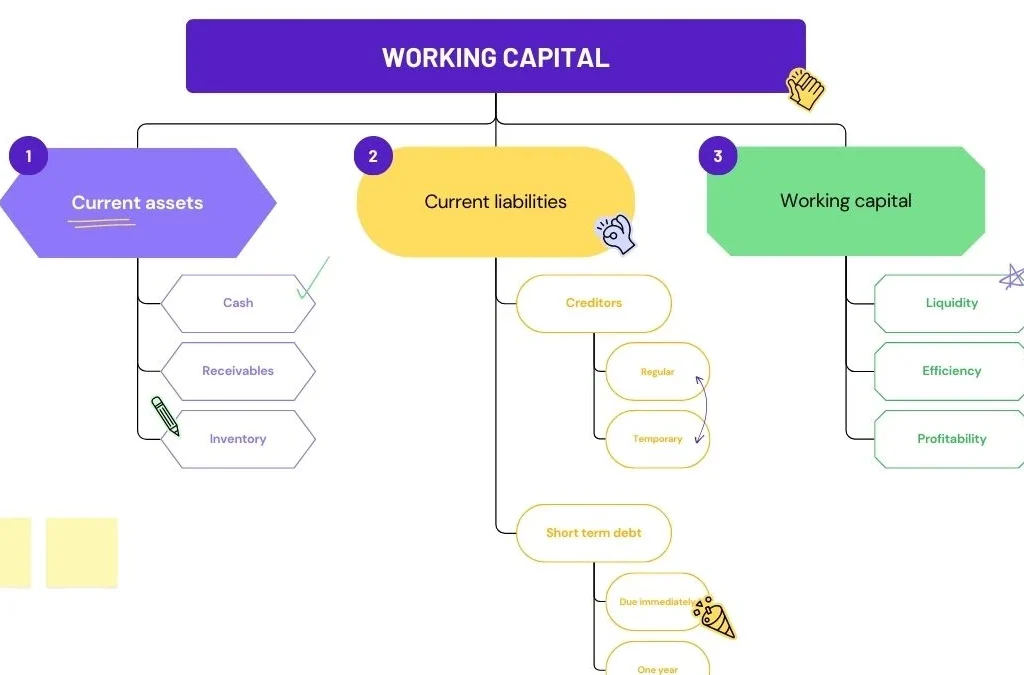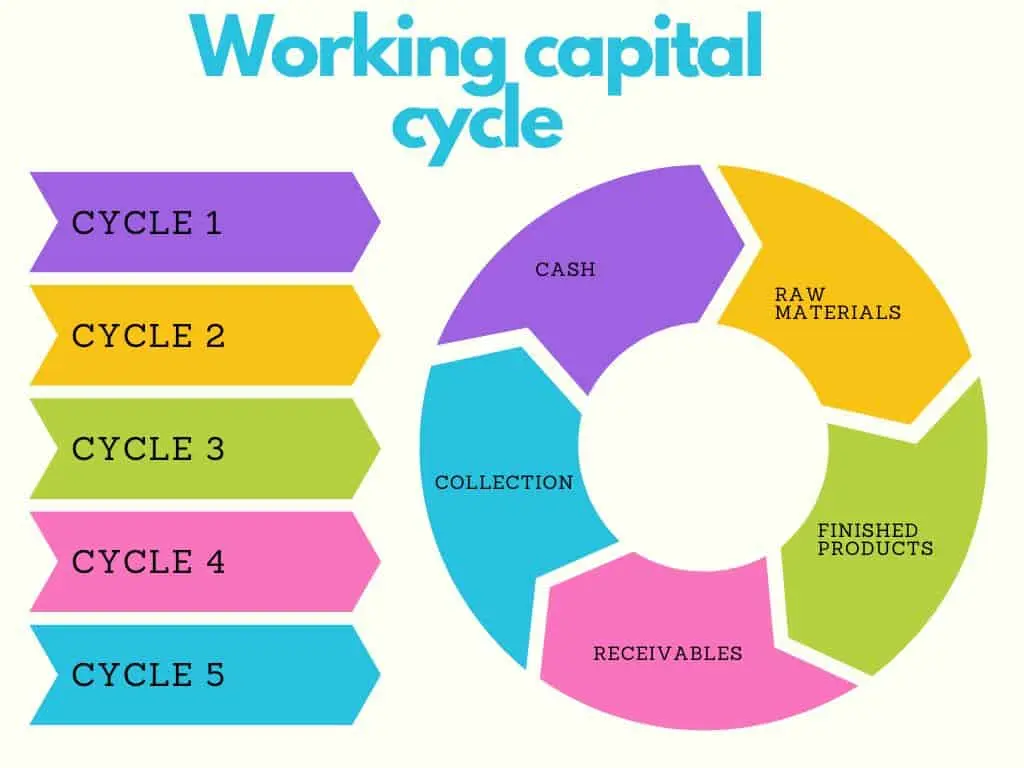What is working capital?
Working capital management is a fundamental financial concept that fuels the daily operations of a business like the lifeblood that sustains it. In essence, it represents the difference between a company’s current assets and its current liabilities.
These assets include cash, inventory, accounts receivable, and short-term investments, while current liabilities comprise debts and expenses due within a year.

The working capital essentially reflects a company’s ability to manage its short-term financial obligations efficiently and maintain smooth operations. Positive working capital indicates that a company can meet its immediate financial needs and invest in growth, while negative working capital may suggest potential liquidity challenges.
Understanding and managing working capital is crucial for businesses of all sizes to ensure stability, support growth, and foster a healthy financial foundation for long-term success.
Types of working capital
Regular Working Capital:
It covers routine expenses, wages, and inventory requirements that ensure smooth day-to-day operations.
Seasonal Working Capital:
Some businesses experience fluctuations in demand due to seasonal trends. Seasonal working capital addresses the increased requirements during peak periods and helps tide over lean seasons.
Special Working Capital:
Specific projects or ventures may demand dedicated funding. Special working capital is allocated to finance these unique initiatives.
Gross Working Capital:
An analysis of a company’s financial health is provided by its total current assets.
Net Working Capital:
Calculated by deducting current liabilities from current assets, net working capital offers insights into a company’s short-term liquidity.
Negative Working Capital:
This occurs when current liabilities surpass current assets, indicating potential financial challenges that require attention and management.
Working capital cycle
The working capital cycle is the time it takes for a business to convert its raw materials into finished goods, sell them, and collect payments from customers. It starts when a company pays for inventory and ends when it receives cash from sales.

Managing this cycle efficiently is crucial as it affects a company’s cash flow, liquidity, and overall financial health. A shorter working capital cycle allows for better cash management and increased operational agility. Working capital health can be determined by a company’s current ratio.
What is working capital management
It is the strategic process of efficiently overseeing a company’s short-term assets and liabilities to ensure smooth operations and financial stability.
It involves optimizing the levels of inventory, accounts receivable, and accounts payable to strike the right balance between cash flow and profitability. Effective working capital management enables businesses to meet their financial obligations, seize growth opportunities, and reduce the risk of insolvency.
By adopting prudent practices like inventory control, credit management, and timely collections, companies can minimize idle resources and enhance overall efficiency. This proactive approach to working capital ensures that a company maintains a strong financial position, sustains growth, and remains resilient in the face of economic fluctuations.
Components of working capital management
It comprises several key components essential for maintaining a healthy financial position. These components include:
Inventory Management:
Efficiently managing inventory levels to prevent overstocking or stockouts while optimizing cash flow and operational efficiency.
Accounts Receivable Management:
Monitoring and expediting the collection of outstanding customer payments to minimize the cash conversion cycle.
Accounts Payable Management:
Strategically manage payments to suppliers to take advantage of credit terms without affecting vendor relationships.
Cash Management:
Ensuring adequate cash reserves for day-to-day operations and investment opportunities.
Short-term Financing:
Utilizing appropriate short-term financing options to cover any temporary cash shortfalls.
Importance of working capital management
Liquidity:
Effective working capital management ensures sufficient funds are available to meet short-term obligations, preventing cash flow crises.
Operational Efficiency:
Optimized inventory, receivables, and payables streamline operations, reducing idle resources and boosting productivity.
Profitability:
Proper management leads to reduced costs, improved cash flow, and increased profitability.
Business Growth:
Adequate working capital enables seizing growth opportunities, expanding operations, and staying competitive.
Credibility:
Strong working capital signals financial stability, fostering trust among suppliers, lenders, and stakeholders.
Risk Mitigation:
Managing short-term financial risks minimizes the possibility of bankruptcy or insolvency.
Strategic Decision-making:
Reliable working capital data aids in making informed decisions and long-term planning.
Pro tips for working capital management
Regularly Monitor Cash Flow:
Keep a close eye on cash inflows and outflows to identify potential shortfalls or surpluses.
Forecasting:
Create accurate cash flow forecasts to anticipate cash needs and plan accordingly.
Efficient Inventory Control:
Optimize inventory levels to prevent tying up excess funds in stock and minimize carrying costs.
Streamlined Receivables:
Implement proactive credit policies and promptly follow up on outstanding payments to shorten the collection cycle.
Negotiate with Suppliers:
Negotiate favorable terms with suppliers to manage payables effectively and preserve cash.
Short-term Financing:
Explore short-term financing options like lines of credit or invoice factoring to address temporary cash shortages.
Focus on Working Capital Ratios:
Monitor key ratios like the current ratio and quick ratio to gauge financial health and make informed decisions.
Continuous Improvement:
Regularly review and refine working capital strategies to adapt to changing business conditions.
A practical example of working capital management
Let’s consider a practical example in action using a retail company named “ABC Clothing.”
ABC Clothing regularly reviews its inventory turnover and identifies slow-moving items. By optimizing inventory levels and negotiating with suppliers for just-in-time deliveries, they reduce excess stock and carrying costs. As a result, they free up cash that can be used for other essential business needs.
Moreover, ABC Clothing implements a strict credit policy for its customers, offering incentives for early payments and maintaining a close eye on overdue accounts. This approach accelerates cash inflows and reduces the average collection period.
To ensure smooth operations during seasonal peaks, ABC Clothing arranges short-term financing, like a line of credit, to cover any temporary cash shortages. This prevents disruptions in supply chain operations and enables them to capitalize on sales opportunities.
By diligently managing working capital through inventory control, credit management, and short-term financing, ABC Clothing enhances cash flow, reduces financial risks, and achieves sustainable growth in the competitive retail industry.
Also refer: Working Capital Software Solutions and Services




